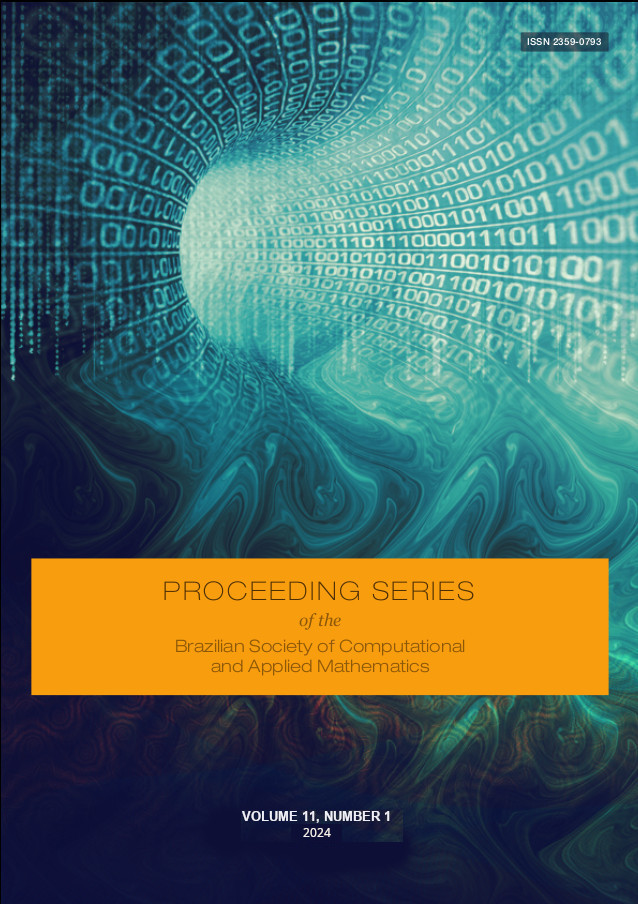Homogeneização de uma barra não periódica funcionalmente graduada via método de dois espaços
DOI:
https://doi.org/10.5540/03.2025.011.01.0407Palabras clave:
Barra Micro-Heterogênea Funcionalmente Graduada, Método de Dois Espaços de Homogeneização Assintótica Não Periódica, Solução Assintótica Formal, Coeficiente Efetivo, Problema HomogeneizadoResumen
Apresenta-se a aplicação do método de homogeneização não periódica de dois espaços para modelar o comportamento efetivo de uma barra micro-heterogênea funcionalmente graduada com comportamento constitutivo linear. Um exemplo é apresentado para ilustrar o fato de que a solução exata do problema que modela o comportamento da barra tende para a solução do chamado problema homogeneizado que modela o comportamento da barra homogênea equivalente obtido da aplicação do método de dois espaços.
Descargas
Citas
G. Allaire. “Homogenization and two-scale convergence”. Em: SIAM Journal on Mathematical Analysis 23 (1992), pp. 1482–1518. doi: 10.1137/0523084.
N. S. Bakhvalov e G. P. Panasenko. Homogenisation: averaging processes in periodic media. 1a. ed. Dordrecht: Kluwer, 1989. isbn: 9789401075060.
A. Bensoussan, J.-L. Lions e G. Papanicolau. Asymptotic analysis for periodic structures. 1a. ed. Amsterdam: North-Holland, 1978. isbn: 9780444851727.
E. De Giorgi. “G-operators and Γ-convergence”. Em: Proceedings of the International Congress of Mathematicians (Vol. 2). 1984, pp. 1175–1191. isbn: 0444866694.
R. P. Feynman, R. B. Leighton e M. Sands. The Feynman Lectures on Physics. Online ed. (feynmanlectures.caltech.edu). Pasadena: California Institute of Technology, 2013.
J. B. Keller. “Darcy’s law for flow in porous media and the two-space method”. Em: Nonlinear Partial Equations in Engineering and Applied Science: Lecture Notes in Pure and Applied Mathematics. Ed. por R. L. Sternberg, A. J. Kalinowski e J. S. Papadakis. Vol. 54. Dekker, 1980. Cap. 27, pp. 429–443. isbn: 0824769961.
J. B. Keller. “Effective behavior of heterogeneous media”. Em: Proceedings of the Symposium on Statistical Mechanics and Statistical Methods in Theory and Applications. 1977, pp. 631–644. doi: 10.10007/978-1-4613-4166-6.
R. Lipton e D. R. S. Talbot. “Bounds for the effective conductivity of a composite with an imperfect interface”. Em: Proceedings of the Royal Society of London A 457 (2001), pp. 1501–1517. doi: 10.1098/rspa.2000.0775.
F. Murat e L. Tartar. “H-convergence”. Em: Topics in the Mathematical Modelling of Composite Materials. Progress in Nonlinear Differential Equations and Their Applications. Ed. por A. Cherkaev e R. Kohn. Vol. 31. Springer, 1997. Cap. 3, pp. 21–43. doi: 10.1007/978-1-4612-2032-9_3.
G. Nguetseng. “A general convergence result for a functional related to the theory of homogenization”. Em: SIAM Journal on Mathematical Analysis 20 (1989), pp. 608–623. doi: 10.1137/0520043.
G. Nguetseng. “Homogenization structures and applications I”. Em: Zeitschrift für Analysis und ihre Anwendungen 22 (2003), pp. 73–108. doi: 10.4171/ZAA/1133.
G. P. Panasenko. “Homogenization for periodic media: from microscale to macroscale”. Em: Physics of Atomic Nuclei 71 (2008), pp. 681–694. doi: 10.1134/S106377880804008X.
P. Ponte Castañeda. “Second-order homogenization estimates for nonlinear composites incorporating field fluctuations: I-theory”. Em: Journal of the Mechanics and Physics of Solids 50 (2002), pp. 737–757. doi: 10.1016/S0022-5096(01)00099-0.
P. Ponte Castañeda e E. Tiberio. “A second-order homogenization method in finite elasticity and applications to black-filled elastomers”. Em: Journal of the Mechanics and Physics of Solids 48 (2000), pp. 1389–1411. doi: 10.1016/S0022-5096(99)00087-3.
S. Spagnolo. “Convergence in energy for elliptic operators”. Em: Proceedings of the Third Symposium on the Numerical Solution of Partial Differential Equations. 1976, pp. 469–499. doi: 10.1016/B978-0-12-358503-5.50021-X.
D. R. S. Talbot. “Bounds which incorporate morphological information for a nonlinear composite dielectric”. Em: Proceedings of the Royal Society of London A 455 (1999), pp. 3617–3628. doi: 10.1098/rspa.1999.0468.
D. R. S. Talbot. “Improved bounds for the effective properties of a nonlinear two-phase elastic composite”. Em: Journal of the Mechanics and Physics of Solids 48 (2000), pp. 1285–1294. doi: 10.1016/S0022-5096(99)00084-8.
D. R. S. Talbot e J. R. Willis. “Bounds for the effective constitutive relation of a nonlinear composite”. Em: Proceedings of the Royal Society of London A 460 (2004), pp. 2705–2723. doi: 10.1098/rspa.2004.1309.
L. Tartar. The General Theory of Homogenization: A Personalized Introduction. 1a. ed. Heidelberg: Springer, 2009. isbn: 9783642051944.

